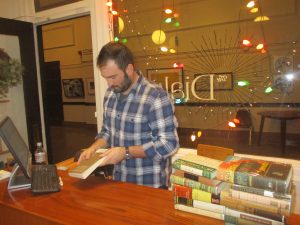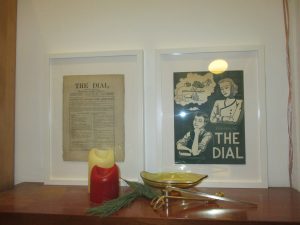New Chicago downtown bookstore takes page from history
By Igor Studenkov For Chronicle Media — January 9, 2018
The Dial co-owner Aaron Lippelt processes a book for shelving. (Photo by Igor Studenkov/for Chronicle Media)
For the past decade, Selected Works and Sheet Music used bookstore — or, as many longtime customers knew it, the Bookstore With a Cat — has been a fixture of downtown Chicago’s Fine Arts Building.
So when owner Keith Peterson closed his store in June 2017 due to declining sales, customers and fellow building tenants were left wondering whether anything would fill their void.
In November 2017, they got their answer, when The Dial bookstore opened. Taking its name from the literary magazine that was published in the building from 1896-1916, it set out to recognize the space’s legacy while forging its own path. Co-owners Mary Gibbons and Aaron Lippelt, who also own Pilsen Community Books used bookstore, are still looking at what their customers are interested in to get a better idea of what they should sell. And they are looking to hold author events, both in the store and in performance spaces elsewhere in the building.
Located at 405 S. Michigan Ave., Fine Arts building is one of historic Michigan Avenue’s more distinct structures. According to the Chicago Architecture Foundation, it was originally built in 1885 by Studebaker Carriage Company as its first retail hub. By 1897, the company became successful enough to move to a larger structure further west, on Wabash Avenue.
According to the building’s official website, at this point, music publisher Charles Curtiss, a music publisher and a friend of the Studebaker family, proposed turning the building into a space devoted to fine arts, where artists could rent studios and musicians could put on performances. The modified building opened a year later.
For the next 119 years, it served as home to a number of publications, artist studios, art-orientated stores, dance studios and musical performance spaces. Some of its famous tenants included author L. Frank Baum and architect Frank Lloyd Wright. And while the building saw some changes and renovations, it still serves the same purpose, and most of its features endure to this day.
Perhaps one of its more distinguishing features is that it’s one of a handful of Chicago buildings that still has manually operated elevators that require lift operators.
Selected Works wasn’t the building’s first bookstore — that honor goes to a since-shuttered bookstore designed by Wright. Nor was the space on second floor of the Fine Arts Building, to the right of the elevators, Selected Works’ original location — until 2007, it was located in Wrigleyville. But after it moved to the Fine Arts building, Peterson became an owner of a kitten named Hodge. The cat became a regular presence in its store — hence the nickname.
Almost 10 years later, Peterson announced that he was retiring and closing the store for good. In an interview with “South Side Weekly,” he cited the decline in print book sales as a reason.
By that point, Gibbons and Lippelt have already been running Pilsen Community Books for around a year and a half. As Lippelt explained to the Chronicle, he and Gibbons met while working for Open Books, a nonprofit that uses its two bookstores — one in Pilsen and one in West Loop — to help fund its community literacy programs. What they experience made them want to strike out on their own and try to launch something similar.
“People in Pilsen loved the warehouse [store],” Lippelt recalled. “[Gibbons and I] wanted to give our own experience a try.”
The duo started out with a pop-up store. It proved to be so popular that they decided to try something permanent. But they didn’t want to open it just anywhere in Pilsen — they were looking to open something on 18th Street, the neighborhood’s main commercial corridor.
“It took us a while to open a storefront that was good rent,” Lippelt said.
Pilsen Community Books opened in February 2016. The duo hired Manuel Morales y Méndez, an experienced bookseller who worked in a number of bookstores in and around Chicago, to handle the store’s day-to-day operations.
Mendez knew Peterson, and when he found out about Selected Books’ impending closure, he urged his employers to open something in its place. Lippelt said that he and Gibbons weren’t sure whether anything would come of it, but they were pleasantly surprised by the response.
“We talked to the owner of the [Fine Arts] building and he was great,” he said. “He really wanted to keep the bookstore legacy alive. He was super accommodating.”
Selected Works’ shelves made for a famously labyrinthine layout. As Lippelt recalled, when he and Gibbons got a look at the empty space, they were shocked at how much space there actually was.
The duo got their own shelves and used them to split the space into a front area and three three-wall “rooms,” with especially tall shelves placed by the walls. Gibbons told the Chronicle that the top shelves that weren’t easy to reach were stocked with duplicates of books that were easier to reach and other materials customers may not be in high demand — but they may add a ladder in the future.
While most of the books are on the shelves, it also has some tables worth of books. They also sell greeting cards and notebooks — items that Selected Works didn’t sell, but which wouldn’t be out of place in many modern bookstores.
In a unique touch, the duo decorated the walls with front pages from the journal that gave the store its name. Lippelt said that they didn’t know The Dial even existed until Mendez did in-depth research on the building. He and Gibbons felt that the name fit.

Covers of The Dial magazine decorate the walls of the bookstore that took its name as a tribute. (Photo by Igor Studenkov/for Chronicle Media)
Select Works specialized in literary fiction, poetry and books dealing with other Humanities disciplines — art, philosophy, drama and music. And, as the name implied, it had a large selection of sheet music.
Lippelt said that, for now, they are choosing which books to stock using the same principle as their Pilsen store — around “90-95 percent” used books, older and higher-priced vintage books and a few new books. But that may change depending on what their customers ask for.
“We have to wait and see,” he said. “It will take us a few months to see what types of books our customers are into.”
Lippelt said that they weren’t limiting themselves to any particular genres, noting that the middle “room” had art and design books, and they had children’s books.
As for carrying fantasy and science fiction, Gibbons said that it wasn’t something they had much of, but they didn’t mean they didn’t stock any. For example, the recently published translations of Russian science fiction novels by Arkady and Boris Strugatsky, which are considered classics in much of the former Soviet Union, would be something they would carry.
When asked about running a store in Fine Arts Building, Lippelt said that the experience has been “fantastic.”
“It was an absolute blessing for Mary and I,” he said. “We could never imagine we’d be in a building this nice. And we love the architecture. So this was a dream come true for us.”
Lippelt said that, thanks to the sounds of musical instruments coming from other spaces give the building a unique ambiance. So does the fact that many of their customers and musicians and dancers who work and practice in the building.
“It’s a great creative space,” Lippelt said.
He also said that the store is getting customers from the nearby businesses who stop by during lunch break, as well as students from the nearby School of Art Institute of Chicago and Columbia College.
“The customers are very happy to have this place,” he said. “A lot of people — they like the place [because] it’s very serene. A lot of people come here just to relax and refresh their minds.”
Lippelt also feels that the fact that, while there are two bookstores nearby — Printers Row’s Sandmeyer’s bookstore and DePaul University Barnes & Noble location — the Dial is the Loop’s only used bookstore.
“There’s definitely a different feel to a used bookstore [as opposed to] the new bookstore,” he said.
Lippert also mentioned that they benefited from Open Studios. Every second Friday of the month, all of the building tenants open their doors to visitors. He was only there for the November and December Open Studios, but both attracted “quite a few people.”
Going forward, one major priority for The Dial will be to do author events, both inside the store and the other performance spaces in the building.
“We hope to do a lot of author readings,” Lippelt said. “We want to do readings here. We want it do in the big theater, and the one on the 10th floor.”
He noted that, even as he and Gibbons keep their eye on what the customers want, the store is still growing.
“Since we’re new, we’re still adding about 300-400 titles new arrivals every week,” he said. “I always tell this to people about the Pilsen store as well — we always have new, interesting stock. A lot of customers like this because they always see new things on the shelves.”
— New Chicago downtown bookstore takes page from history —




